Статьи журнала - International Journal of Intelligent Systems and Applications
Все статьи: 1126
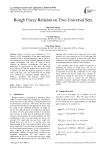
Rough Fuzzy Relation on Two Universal Sets
Статья научная
Fuzzy set theory was introduced by L.A. Zadeh in 1965. Immediately, it has many applications in practice and in building databases, one of which is the construction of a fuzzy relational database based on similar relationship. The study of cases of fuzzy relations in different environments will help us understand its applications. In this paper, the rough fuzzy relation on Cartesian product of two universe sets is defined, and then the algebraic properties of them, such as the max, min, and composition of two rough fuzzy relations are examined. Finally, reflexive, α-reflexive, symmetric and transitive rough fuzzy relations on two universe sets are also defined.
Бесплатно
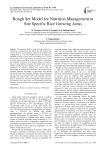
Rough Set Model for Nutrition Management in Site Specific Rice Growing Areas
Статья научная
The optimized fertilizer usage for better yield of rice cultivation is influenced by key factors like soil fertility, crop variety, duration, season, nutrient content of the fertilizer, time of application etc., It is observed that 60 percent of yield gap in tamilnadu is due to farmers lack of knowledge on key factors and informal sources of information by pesticide dealers. In this study the major contributing factors for fertilizer requirement and optimum crop yield were analyzed based on rough set theory. In data analytics perspective the nutrient plan is sort of multiple attribute decision-making processes. To reduce the complexity of decision making, key factors that are indiscernible to conclusion are eliminated. Our rough set based approach improved the quality of agricultural data through removal of missing and redundant attributes. After pretreatment the data formed as target information, then attribute reduction algorithm was used to derive rules. The generated rules were used to structure the nutrition management decision-making. The precision was above 88% and experiments proved the feasibility of the developed decision support system for nutrient management.
Бесплатно
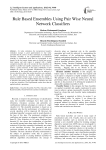
Rule Based Ensembles Using Pair Wise Neural Network Classifiers
Статья научная
In value estimation, the inexperienced people's estimation average is good approximation to true value, provided that the answer of these individual are independent. Classifier ensemble is the implementation of mentioned principle in classification tasks that are investigated in two aspects. In the first aspect, feature space is divided into several local regions and each region is assigned with a highly competent classifier and in the second, the base classifiers are applied in parallel and equally experienced in some ways to achieve a group consensus. In this paper combination of two methods are used. An important consideration in classifier combination is that much better results can be achieved if diverse classifiers, rather than similar classifiers, are combined. To achieve diversity in classifiers output, the symmetric pairwise weighted feature space is used and the outputs of trained classifiers over the weighted feature space are combined to inference final result. In this paper MLP classifiers are used as the base classifiers. The Experimental results show that the applied method is promising.
Бесплатно
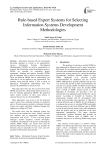
Rule-based Expert Systems for Selecting Information Systems Development Methodologies
Статья научная
Information Systems (IS) are increasingly becoming regarded as crucial to an organization's success. Information Systems Development Methodologies (ISDMs) are used by organizations to structure the information system development process. ISDMs are essential for structuring project participants’ thinking and actions; therefore ISDMs play an important role to achieve successful projects. There are different ISDMs and no methodology can claim that it can be applied to any organization. The problem facing decision makers is how to select an appropriate development methodology that may increase the probability of system success. This paper takes this issue into account when study ISDMs and provides a Rule-based Expert System as a tool for selecting appropriate ISDMs. The proposed expert system consists of three main phases to automate the process of selecting ISDMs. Three approaches were used to test the proposed expert system. Face validation through six professors and six IS professionals, predictive validation through twenty four experts and blind validation through nine employees working in IT field. The results show that the proposed system was found to be run without any errors, offered a friendly user interface and its suggestions matching user expectations with 95.8%. It also can help project managers, systems' engineers, systems' developers, consultants, and planners in the process of selecting the suitable ISDM. Finally, the results show that the proposed Rule-based Expert System can facilities the selection process especially for new users and non-specialist in Information System field.
Бесплатно
SMS Tracking System with Doppler Radar to Enhance Car Security for Intelligent Transport System
Статья научная
The World report on road traffic injury prevention presents some assessments and conclusions regarding road traffic accidents, in which they state that more than 1.2 million deaths per year occur on the world’s roads and around 50 million more of injured people. To prevent this people are working for intelligent transport system (ITS). ITS is trying to make an intelligent car which will be able to avoid collation. In this paper we have tried to add a new goal in ITS system which will be activated in the intelligence fails. This SMS system will help to locate a car using GPS, if the car collides. Our total development work is divided into two parts. In first part we have tried to develop a system which will help the driver by providing the road scenario using dopple radar. Doppler radar will measure the velocity of the nearby car or passing by car, depending upon the information our car will be controlled. In second part of development we have developed a auto generated SMS sending system to a specific number if the Car collide. Both systems are described in details in next part of this article.
Бесплатно
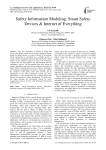
Safety Information Modeling: Smart Safety Devices & Internet of Everything
Статья научная
The next generation of Internet of things that connects the things, people and the process through which the people and things interact is coined as Internet of Everything. Safety management is constructed as a complex system of systems design coordinating with each other like the Fire Alarm System or Gas Detection System as well as the Emergency response like the Fire Fighters and Para-Medicals like the Ambulatory services. The governments have been setting up national broadband plans and separate dedicated spectrum for Public Safety Communications used for effective information rich emergency management and response. This paper outlines the evolution of the public safety LTE network and its applicability in the safety management system and safety preparedness. It also describes the role of Smart Objects and Internet of Everything in Safety Management. To achieve this, this paper develops the information models for safety management systems to be used in IoE utilizing the broad-band LTE networks.
Бесплатно
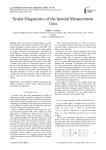
Scalar Diagnostics of the Inertial Measurement Unit
Статья научная
The scalar method of fault diagnosis systems of the inertial measurement unit (IMU) is described. All inertial navigation systems consist of such IMU. The scalar calibration method is a base of the scalar method for quality monitoring and diagnostics. Algorithms of fault diagnosis systems are developed in accordance with scalar calibration method. Algorithm verification is implemented in result of quality monitoring of IMU. A failure element determination is based in diagnostics algorithm verification and after that the reason of such failure is cleared. The process of verifications consists of comparison of the calculated estimations of biases, scale factor errors and misalignments angles of sensors to their data sheet certificate, which kept in internal memory of navigation computer. In result of such comparison the conclusion for working capacity of each one IMU sensor can be made and also the failure sensor can be deter-mined.
Бесплатно
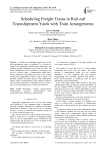
Scheduling freight trains in rail-rail transshipment yards with train arrangements
Статья научная
A problem of scheduling freight trains in rail-rail transshipment yards is considered. It is solved at a deeper level compared to original papers dedicated to this problem: besides scheduling service slots for trains, this article additionally solves a problem of assigning every train to a railway track. A mathematical model and a solving method for this problem are given. A key feature of the given mathematical model is that it doesn’t use Boolean variables but rather operates with combinatorial objects (tuples of permutations). The solution method is also based on generation of combinatorial sets, which is quite an unusual approach for solving such problems.
Бесплатно
Security Based on Real Time Tracking of Multiple Human Faces Identification
Статья научная
Robust tracking of persons in real-world environments and in real-time is a common goal in many video applications. In this paper a computational system for the real-time tracking of multiple persons in natural environments is presented. Face detection has diverse applications especially as an identification solution which can meet the crying needs in security areas. The region extractor is based on the integration of skin-color, motion and silhouette features, while the face detector uses a simple, rule-based face detection algorithm and SVM. Exemplary results of the integrated system working in real-world video sequences. New intelligent processing methods, as well as security requirements make multiple-person tracking a hot area. This application is robust tracking in real-world environments and in real-time.
Бесплатно
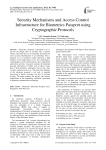
Статья научная
Electronic passports (e-passports) are to prevent the illegal entry of traveller into a specific country and limit the use of counterfeit documents by more accurate identification of an individual. The e-passport, as it is sometimes called, represents a bold initiative in the deployment of two new technologies: cryptography security and biometrics (face, fingerprints, palm prints and iris). A passport contains the important personal information of holder such as photo, name, date of birth and place, nationality, date of issue, date of expiry, authority and so on. The goal of the adoption of the electronic passport is not only to expedite processing at border crossings, but also to increase security. The paper explores the privacy and security implications of this impending worldwide experiment in biometrics authentication technology.
Бесплатно
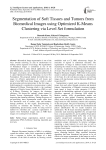
Статья научная
Biomedical Image-segmentation is one of the ways towards removing an area of attentiveness by making various segments of an image. The segmentation of biomedical images is considered as one of the challenging tasks in many clinical applications due to poor illuminations, intensity inhomogeneity and noise. In this paper, we propose a new segmentation method which is called Optimized K-Means Clustering via Level Set Formulation. The proposed method diversified into two stages for efficient segmentation of soft tissues and tumor’s from MRI brain Scans Images, which is called pre-processing and post-processing. In the first stage, a hybrid approach is considered as pre-processing is called Optimized K-Means Clustering which is the combined approach of Particle Swarm Optimization (PSO) as well as K-Means Clustering for improve the clustering efficiency. We choose the ‘optimal’ cluster centers by Particle Swarm Optimization (PSO) algorithm for improving the clustering efficiency. During the process of pre-processing, these segmentation results suffer from few drawbacks such as outliers, edge and boundary leakage problems. In this regard, post-processing is necessary to minimize the obstacles, so we are implementing pre-processing results by using level-set method for smoothed and accurate segmentation of regions from biomedical images such as MRI brain images over existing level set methods.
Бесплатно
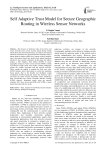
Self Adaptive Trust Model for Secure Geographic Routing in Wireless Sensor Networks
Статья научная
The presence of malicious nodes in the ad hoc and sensor networks poses serious security attacks during routing which affects the network performance. To address such attacks, numerous researchers have proposed defense techniques using a human behavior pattern called trust. Among existing solutions, direct observations based trust models have gained significant attention in the research community. In this paper, the authors propose a Self Adaptive Trust Model (SATM) of secure geographic routing in wireless sensor networks (WSNs). Unlike conventional weight based trust models, SATM intelligently assigns the weights associated with the network activities. These weights are applied to compute the final trust value. SATM considers direct observations to restrict the reputation based attacks. Due to the flexible and intelligent weight computation, SATM dynamically detects the malicious nodes and direct the traffic towards trustworthy nodes. SATM has been incorporated into Greedy Perimeter Stateless Routing (GPSR) protocol. Simulation results using the network simulator NS-2 have shown that GPSR with SATM is robust against detecting malicious nodes.
Бесплатно
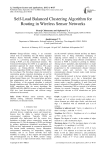
Self-Load Balanced Clustering Algorithm for Routing in Wireless Sensor Networks
Статья научная
Energy-efficient routing is an extremely critical issue in unattended, tiny and battery equipped Wireless Sensor Networks (WSNs). Clustering the network is a promising approach for energy aware routing in WSN, as it has a hierarchical structure. The Connected Dominating Set (CDS) is an appropriate and prominent approach for cluster formation. This paper proposes an Energy-efficient Self-load Balanced Clustering algorithm (SLBC) for routing in WSN. SLBC has two phases: The first phase clusters the network by constructing greedy connected dominating set and the nodes are evenly distributed among them, using the defined parent fitness cost. The second phase performs data manipulations and new on-demand re-clustering. The efficiency of the proposed algorithm is analysed through simulation study. The obtained results show that SLBC outperforms than the recent algorithms like GSTEB and DGA-EBCDS in terms of network lifetime, CDS size, load dissemination, and efficient energy utilization of the network.
Бесплатно
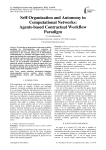
Self-Organization and Autonomy in Computational Networks:Agents-based Contractual Workflow Paradigm
Статья научная
We describe an agents-based contractual workflow paradigm for Self-organization and autonomy in computational networks. The agent-based paradigm can be interpreted as the outcome arising out of deterministic, nondeterministic or stochastic interaction among a set of agents that includes the environment. These interactions are like chemical reactions and result in self-organization. Since the reaction rules are inherently parallel, any number of actions can be performed cooperatively or competitively among the subsets of elements, so that the agents carry out the required actions. Also we describe the application of this paradigm in finding short duration paths, chemical- patent mining, and in cloud computing services.
Бесплатно
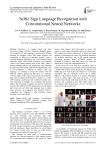
Selfie sign language recognition with convolutional neural networks
Статья научная
Extraction of complex head and hand movements along with their constantly changing shapes for recognition of sign language is considered a difficult problem in computer vision. This paper proposes the recognition of Indian sign language gestures using a powerful artificial intelligence tool, convolutional neural networks (CNN). Selfie mode continuous sign language video is the capture method used in this work, where a hearing-impaired person can operate the Sign language recognition (SLR) mobile application independently. Due to non-availability of datasets on mobile selfie sign language, we initiated to create the dataset with five different subjects performing 200 signs in 5 different viewing angles under various background environments. Each sign occupied for 60 frames or images in a video. CNN training is performed with 3 different sample sizes, each consisting of multiple sets of subjects and viewing angles. The remaining 2 samples are used for testing the trained CNN. Different CNN architectures were designed and tested with our selfie sign language data to obtain better accuracy in recognition. We achieved 92.88 % recognition rate compared to other classifier models reported on the same dataset.
Бесплатно
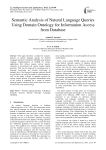
Статья научная
This paper describes a method for semantic analysis of natural language queries for Natural Language Interface to Database (NLIDB) using domain ontology. Implementation of NLIDB for serious applications like railway inquiry, airway inquiry, corporate or government call centers requires higher precision. This can be achieved by increasing role of language knowledge and domain knowledge at semantic level. Also design of semantic analyzer should be such that it can easily be ported for other domains as well. In this paper a design of semantic analyzer for railway inquiry domain is reported. Intermediate result of the system is evaluated for a corpus of natural language queries collected from casual users who were not involved in the system design.
Бесплатно
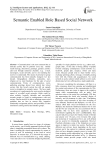
Semantic Enabled Role Based Social Network
Статья научная
Communication is the most common but an intricate activity that we perform every day. Sender sends message, discussions, greetings, gestures, emotics and texts through numerous channels, (e.g. e-mail, messengers, social networks and so on) intending the receiver to understand. The means of personal or group communication has been radically changed over last decade. Geographical, ethnicity, nationality, race, religion are no more hindrance for the sake of social communication. Forms of communication, event, gathering, greetings almost have altered into virtual society. But this hi-tech society has still yet enough room to strengthen its semantic nature. We have made an endeavor to conglomerate the socio-psycho-technical aspect of so-called social networks which could be more realistic, logically inferable and convincible towards people to claim its analogousness with real society. Our devised SN is able to eliminate some weird problems that we face in current SNs, imperfect relationship assignment policies and possibility of data interference among desired and intruder groups.
Бесплатно
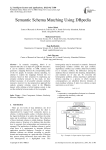
Semantic Schema Matching Using DBpedia
Статья научная
In semantic computing, Match is an operator that takes as an input two graph-like structures; it can be database schemas or XML schemas and generates a mapping between the corresponding nodes of the two graphs. In semantic schema matching, we attempt to explore the mappings between the two schemas; based on their semantics by employing any semantic similarity measure. In this study, we have defined taxonomy of all possible semantic similarity measures; moreover we also proposed an approach that exploits semantic relations stored in the DBpedia dataset while utilizing a hybrid ranking system to dig out the similarity between nodes of the two graphs.
Бесплатно
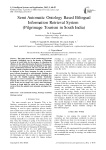
Статья научная
This paper focuses on the construction of a Semi Automatic Ontological tree in the domain of Pilgrimage Tourism in South India for the purpose of enhancing the efficiency in the online Information Retrieval. The proposed system uses two languages Tamil and English for the input query and document retrieval. The user can pose the query in either Tamil or English and the resultant document will be displayed in the query language. In order to retrieve more relevant documents, a semi-automatic Ontology tree has been constructed. The semi automatic ontological tree uses only the English language. Machine Translation approach is used to translate the retrieved result to the language that of the user’s query. Our system produces the better results for the simple user’s query about Pilgrimage Tourism in South India for which the answers could be retrieved from the updated semi automatic ontological tree itself.
Бесплатно
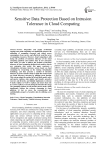
Sensitive Data Protection Based on Intrusion Tolerance in Cloud Computing
Статья научная
Service integration and supply on-demand coming from cloud computing can significantly improve the utilization of computing resources and reduce power consumption of per service, and effectively avoid the error of computing resources. However, cloud computing is still facing the problem of intrusion tolerance of the cloud computing platform and sensitive data of new enterprise data center. In order to address the problem of intrusion tolerance of cloud computing platform and sensitive data in new enterprise data center, this paper constructs a virtualization intrusion tolerance system based on cloud computing by researching on the existing virtualization technology, and then presents a method of intrusion tolerance to protect sensitive data in cloud data center based on virtual adversary structure by utilizing secret sharing. This system adopts the method of hybrid fault model, active and passive replicas, state update and transfer, proactive recovery and diversity, and initially implements to tolerate F faulty replicas in N=2F+1 replicas and ensure that only F+1 active replicas to execute during the intrusion-free stage. The remaining replicas are all put into passive mode, which significantly reduces the resource consuming in cloud platform. At last we prove the reconstruction and confidentiality property of sensitive data by utilizing secret sharing.
Бесплатно

